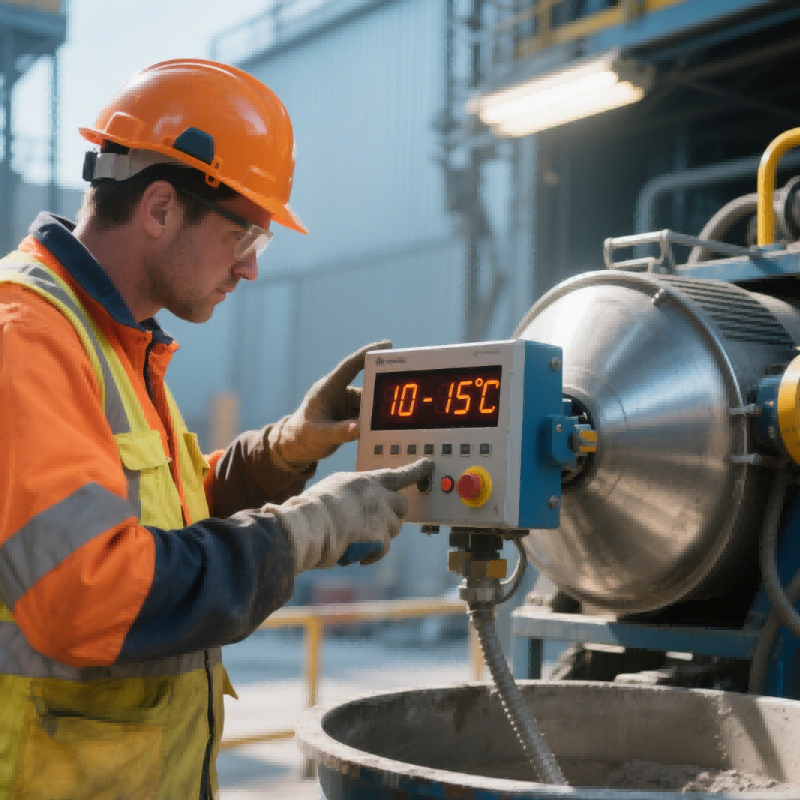
search
Concrete is the foundation of modern construction, used in everything from skyscrapers to bridges and highways. However, producing high-quality concrete requires more than just mixing cement, water, and aggregates. One critical factor that often goes unnoticed is temperature control. Without proper cooling, the concrete mix can suffer from reduced strength, cracking, and durability issues.
This is where ice and cement cooling systems come into play. In this blog, we'll explore why ice is used in concrete, how cement cooling systems work, and why they are essential for producing high-quality concrete.
Concrete production involves a chemical reaction called hydration, where cement reacts with water to form a hard, durable material. However, this reaction generates heat, known as hydration heat, which can cause the temperature of the concrete mix to rise significantly.
Cracking: High temperatures can cause the concrete to set too quickly, leading to cracks.
Reduced Strength: Rapid hydration can weaken the concrete's structural integrity.
Durability Issues: Overheating can compromise the long-term durability of the concrete.
To address these challenges, temperature control is critical, especially in hot climates or large-scale projects. This is where ice becomes an invaluable tool.
Ice is one of the most effective methods for cooling concrete during production. By replacing a portion of the mixing water with ice, the temperature of the concrete mix can be significantly reduced.
Prevents Rapid Hydration: Ice slows down the hydration process, ensuring the concrete sets at the right pace.
Improves Strength and Durability: By maintaining optimal temperatures, ice helps produce stronger, more durable concrete.
Reduces Cracking: Lower temperatures minimize the risk of thermal cracking, especially in large pours or hot weather conditions.
Ensures Consistency: Ice ensures uniform cooling, resulting in consistent concrete quality across batches.
In hot climates or during summer months, using ice is not just a precaution—it's a necessity.

While ice is a key component of concrete cooling, it's not the only solution. A cement cooling system is a comprehensive setup designed to maintain the optimal temperature of the concrete mix throughout the production process.
Ice Plants: Produce and store ice for use in the concrete mix.
Ice Conveyor Systems: Transport ice efficiently from storage to the mixing area.
Aggregate Cooling Systems: Cool the aggregates (sand, gravel, and crushed stone) before they are mixed with cement and water.
Chilled Water Systems: Provide additional cooling by replacing regular water with chilled water in the mix.
These components work together to ensure that the concrete mix remains within the desired temperature range, even in challenging conditions.
Investing in ice and cement cooling systems offers several advantages for concrete production:
By maintaining optimal temperatures, cooling systems prevent defects like cracking and ensure the concrete achieves its intended strength and durability.
Automated cooling systems streamline the production process, allowing for faster and more efficient concrete mixing, even in large-scale projects.
Efficient cooling systems reduce waste and operational costs, making them a cost-effective solution in the long run.
Modern cooling systems are designed to be energy-efficient, reducing both energy consumption and environmental impact.
Cement cooling systems are used in a variety of industries and projects where temperature-controlled concrete is essential. Common applications include:
Large-Scale Infrastructure Projects: Bridges, dams, and highways.
High-Rise Buildings: Skyscrapers and commercial complexes.
Precast Concrete Production: Factories producing precast concrete elements.
Hot Climate Construction: Projects in regions with high ambient temperatures.
For example, in the construction of a dam in a tropical region, a cement cooling system can ensure that the concrete remains stable and durable despite the extreme heat.
Selecting the right cement cooling system is crucial for the success of your project. Here are some factors to consider:
Assess the volume of ice needed and the scale of your project. Larger projects may require more advanced systems with higher capacities.
Ensure that the system integrates seamlessly with your existing production setup, including ice plants, aggregate cooling systems, and mixing equipment.
Choose a trusted supplier with a proven track record in providing high-quality concrete cooling solutions.
Look for systems with low maintenance requirements and reliable customer support to minimize downtime.
In a recent infrastructure project in the Middle East, where temperatures often exceed 40°C (104°F), a cement cooling system was implemented to produce high-quality concrete. The system combined ice plants, ice conveyor systems, and aggregate cooling to reduce concrete temperatures by 15°C. This ensured consistent quality, prevented cracking, and saved significant costs on repairs and maintenance.
In today's construction landscape, where quality, efficiency, and sustainability are paramount, ice and cement cooling systems are no longer optional—they're essential. By ensuring precise temperature control, these systems help you produce high-quality concrete, meet tight deadlines, and reduce costs.
If you're ready to take your concrete production to the next level, investing in a cement cooling system is the way to go. At FSE, we pride ourselves on being a trusted concrete cooling solutions provider, offering innovative and reliable systems tailored to meet the unique needs of your projects.
With years of expertise in the industry, FSE delivers cutting-edge solutions, including ice plants, ice conveyor systems, and aggregate cooling systems, to ensure your concrete production remains efficient, consistent, and cost-effective. Whether you're working on a small-scale project or a massive infrastructure development, our team is here to help you achieve optimal results.
Q: Why is temperature control important in concrete production?
A: Temperature control prevents rapid hydration, cracking, and durability issues, ensuring high-quality concrete.
Q: How does a cement cooling system work?
A: A cement cooling system uses components like ice plants, ice conveyor systems, and aggregate cooling systems to maintain optimal concrete temperatures.
Q: Can cement cooling systems handle large-scale projects?
A: Yes, modern systems are scalable and can handle the high volumes required for large-scale infrastructure projects.